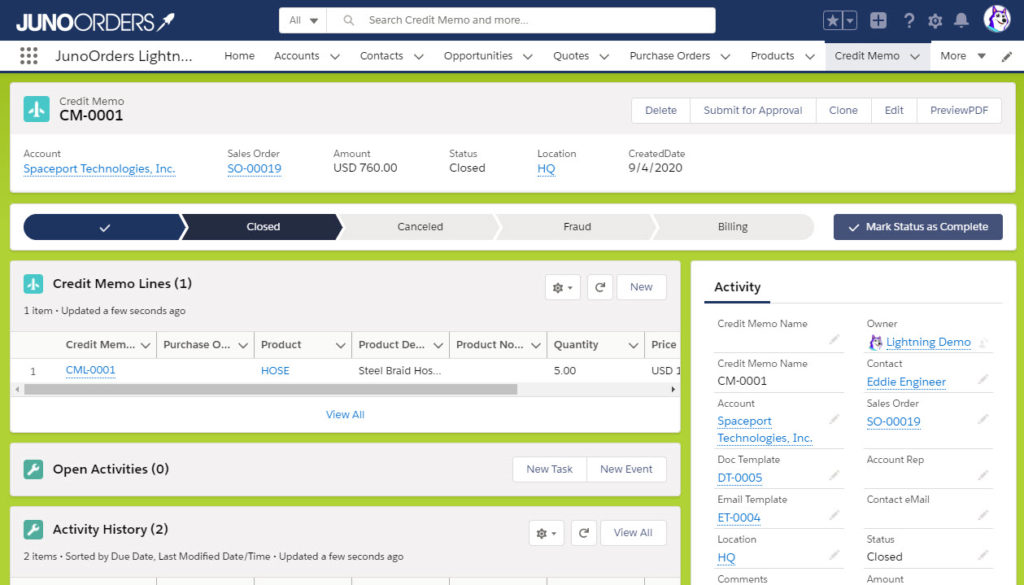

- #Custom salesforce invoicing and payment object how to#
- #Custom salesforce invoicing and payment object install#
If checked, this payment method is automatically considered for creating payments on this Account. It is a picklist having values for Credit Card and ACH. It is a lookup of the payment gateway record used for creating the payment. Here we are using CyberSource as a Payment Gateway, as shown below:
#Custom salesforce invoicing and payment object install#
To configure the payment gateway, we need to install the AppExchange package and follow the steps mentioned in its documentation. Salesforce Billing offers Salesforce payment processing integration with many payment gateways like CyberSource, AuthorizeDotNet, Payeezy, etc. It contains the information for building the connection between salesforce billing and the external gateway. Payment Gateways are external service providers that process payments. Before going into much detail to understand how the invoices are processed for payment, Let's explore the critical fields and functioning of objects like Salesforce Payment Gateway, Payment Method, Payment Scheduler, Payment Run and Payment.The invoice record contains essential details like the balance, due date, and payment status. Invoices display an inventory of purchased items and services alongside the total amount a customer must pay.When it comes to an invoice scheduler, it evaluates order products as per user-defined criteria and creates an invoice with invoice lines. Salesforce Billing allows you to create an invoice record manually or automate the invoice creation process with an Invoice scheduler.This blog will explore more about Salesforce payment processing in Salesforce Billing.īelow is the high-level flow of the Payment Data Model, which involves leading objects like Accounts, Invoice, and Payment. A key to customer satisfaction is invoicing and handling the payment in a way that works best. An organization needs to maintain the correct billing standards. In this way, it plays a significant role in the Quote-to-Cash process. Salesforce Billing picks up the order for generating an invoice, payment, and revenue recognition records. In Salesforce CPQ, a sales rep finalizes a quote and creates an order from it. When it comes to Salesforce Billing, it is termed as an add-on package that automates invoicing and allows businesses to accept and allocate payments on the salesforce platform simply. Application Development & Modernization.In your Salesforce org, click the cog icon, and select Setup. You'll have to make sure you have the appropriate permissions within your organization to do it, but once you have that sorted, just follow these steps:
#Custom salesforce invoicing and payment object how to#
How to create a custom object in SalesforceĬreating a custom object is actually quite simple.

might work on multiple projects for the same customer (and would need to send multiple invoices), they'll want to create a custom object.

But since Winston's Wonderful Painting Co. If the data you're keeping track of is something that will only apply to a record (the customer) once-like an address, for example-then you could just create a custom field, rather than a custom object. wants to see if a customer has paid each time they view the contact in Salesforce, then they'll need to create a custom object for invoices. Invoices isn't a standard object in Salesforce. uses Salesforce to keep track of their leads and customers, but they also use it to track invoices and understand whether or not customers have paid. So how do you know when you should go through the trouble of creating a Salesforce custom object? Let's use an example. You can only have 3,000 custom objects per organization, so use them wisely.) When to create a custom object (Also worth noting: there are Salesforce custom object limits. Once you've created a custom object, you'll be able to associate it with any record you want. Objects are containers for your information, and custom objects are the containers you build yourself to suit your own specific needs. They're objects you create to handle the specific needs of your organization or industry. These include accounts, cases, contacts, and opportunities-the kind of information that almost every organization is keeping tabs on in Salesforce.Ĭustom objects go beyond what comes out of the box. Standard objects are the objects that are included in Salesforce by default. Now, there are two main types of objects in Salesforce. That makes the columns-invoice number, amount, service provided, sent on, and due by-the fields (the type of data collected in each object). In the example above, "Invoices" is the object.


 0 kommentar(er)
0 kommentar(er)
